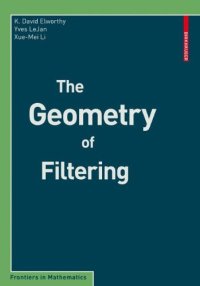
Ebook: The Geometry of Filtering
- Genre: Mathematics // Wavelets and signal processing
- Tags: Global Analysis and Analysis on Manifolds, Differential Geometry, Probability Theory and Stochastic Processes
- Series: Frontiers in Mathematics
- Year: 2010
- Publisher: Birkhäuser Basel
- Edition: 1
- Language: English
- pdf
Filtering is the science of nding the law of a process given a partial observation of it. The main objects we study here are di usion processes. These are naturally associated with second-order linear di erential operators which are semi-elliptic and so introduce a possibly degenerate Riemannian structure on the state space. In fact, much of what we discuss is simply about two such operators intertwined by a smooth map, the projection from the state space to the observations space", and does not involve any stochastic analysis. From the point of view of stochastic processes, our purpose is to present and to study the underlying geometric structure which allows us to perform the ltering in a Markovian framework with the resulting conditional law being that of a Markov process which is time inhomogeneous in general. This geometry is determined by the symbol of the operator on the state space which projects to a symbol on the observation space. The projectible symbol induces a (possibly non-linear and partially de ned) connection which lifts the observation process to the state space and gives a decomposition of the operator on the state space and of the noise. As is standard we can recover the classical ltering theory in which the observations are not usually Markovian by application of the Girsanov- Maruyama-Cameron-Martin Theorem. This structure we have is examined in relation to a number of geometrical topics.
The geometry which is the topic of this book is that determined by a map of one space N onto another, M, mapping a diffusion process, or operator, on N to one on M.
Filtering theory is the science of obtaining or estimating information about a system from partial and possibly flawed observations of it. The system itself may be random, and the flaws in the observations can be caused by additional noise. In this volume the randomness and noises will be of Gaussian white noise type so that the system can be modelled by a diffusion process; that is it evolves continuously in time in a Markovian way, the future evolution depending only on the present situation.
This is the standard situation of systems governed by Ito type stochastic differential equations. The state space will be the smooth manifold, N, possibly infinite dimensional, and the ''observations'' will be obtained by a smooth map onto another manifold, N, say. We emphasise that the geometry is important even when both manifolds are Euclidean spaces. This can also be viewed from a purely partial differential equations viewpoint as one smooth second order elliptic partial differential operator lying above another, both with no zero order term.
We consider the geometry of this situation with special emphasis on situations of geometric, stochastic analytic, or filtering interest. The most well studied case is of one Brownian motion being mapped to another with a consequent skew product decomposition (or equivalently the case of Riemannian submersions). This sort of decomposition is generalised and a key to the rest of the book. It is used to study in particular, classical filtering, (semi-)connections determined by stochastic flows, and generalised Weitzenbock formulae.